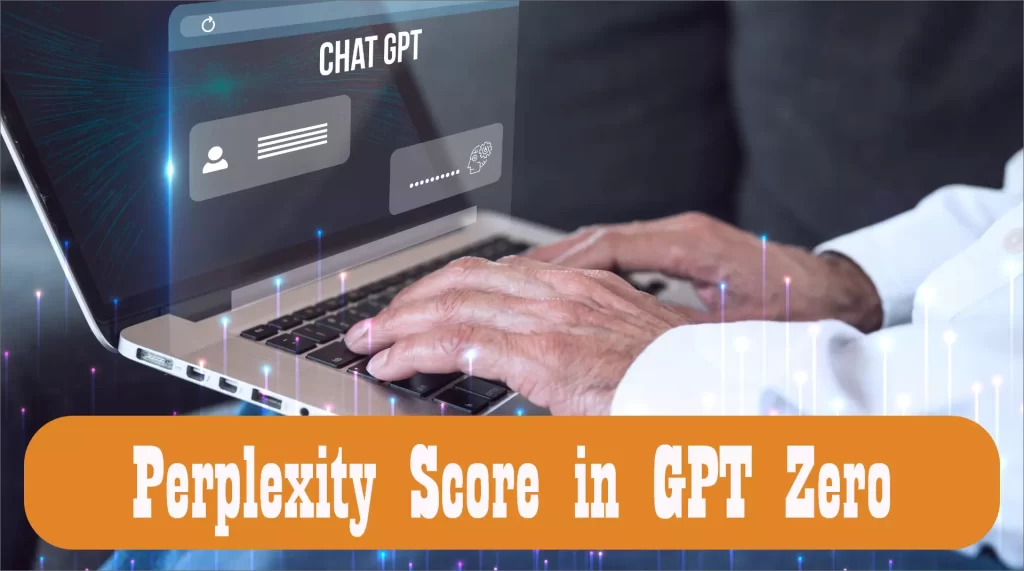What is a High Perplexity Score in GPT Zero?

Artificial intelligence (AI) and natural language processing (NLP) have advanced significantly in recent years, altering how people interact with technology. A cutting-edge language model created by OpenAI, GPT Zero, is one of the significant accomplishments in this field.
Perplexity is a popular metric to assess language models’ efficacy in natural language processing. It assesses how well a language model can foretell a given string of words.
The lower the perplexity score, the model performs better at guessing the subsequent word in a sequence. Understanding the idea of perplexity scores is crucial for authors and content producers, especially when using GPT Zero.
In the context of GPT Zero, this article seeks to clarify the meaning of high confusion scores and the ramifications for content production and SEO optimization.
Perplexity Score: What Is It?
The ability of a language model to discriminate between words it understands and ones it does not is measured by a perplexity score.
As the language model can more precisely discriminate between known and unfamiliar terms, a higher perplexity score suggests a better comprehension of the text by the language model.
A method known as perplexity estimation must be performed on an AI model to determine perplexity scores for GPT Zero.
What is GPT Zero?
A significant development in the field of NLP is GPT Zero, the most recent version of the Generative Pre-trained Transformer model.
GPT Zero exhibits an unmatched capacity to produce prose similar to human writing and comprehend context after training on a large amount of text from many sources.
It has been widely used in content creation, language translation, and code authoring.
Understanding Perplexity in GPT Zero
In GPT Zero, complexity ratings might be anywhere between 10 and over 1000. Perplexity scores range from 0 to 100, with 0 being excellent and 100 being bad. It’s crucial to remember that the ideal perplexity score will vary depending on the particular use case and dataset.
One factor that might affect the perplexity scores in GPT Zero is model size. Because they contain more parameters and can better grasp intricate patterns in linguistic data, larger models typically have lower perplexity ratings.
For instance, the 175 billion parameter GPT-3 model scores a perplexity score of slightly under 20 on various benchmarks, which is remarkably low.
Perplexity Score Calculation in GPT Zero
Perplexity is a widely used statistic for assessing the performance of language models, such as GPT Zero. The model’s forecasts’ perplexity might be viewed as a gauge of their surprise or uncertainty.
A lower perplexity value means the model’s predictions are more confident, whereas a more significant number means more ambiguity.
1. Distribution of Probabilities and Tokenization
Understanding tokenization and probability distribution is crucial before understanding the complexities of determining perplexity. Broken down into individual words or tokens, the text is tokenized before being used to train a language model.
After training, the model employs probability distribution to forecast which word should appear after a series of other words. The next word in the sentence “The cat sat on the” would be predicted by GPT Zero using probability distribution, for instance, if we input that text.
Because “mat” frequently comes after “sat on” in this situation, it may predict “mat” with a high degree of likelihood. However, additional options like “chair” or “floor” are also possible.
2. Perplexity Score Formula
Cross-entropy loss and probability distribution are used to calculate perplexity. The degree to which the expected probability and the actual probabilities agree is gauged by cross-entropy loss.
The formula for confusion is as follows:
Perplexity = 2^cross-entropy loss
The cross-entropy loss is determined via this formula by adding the negative log-likelihoods of each predicted word relative to its context over the whole test set.
Feeding in a test set of texts and contrasting their projected probability with their actual probabilities are the two steps involved in calculating perplexity in GPT Zero. The test and training sets must be kept apart to assess how effectively GPT Zero generalizes to new data.
Once we have determined the cross-entropy loss for each sentence in our test set, we can enter these figures into our perplexity calculation to see how well GPT Zero performed on that specific dataset.
High Perplexity Score in GPT Zero
In GPT Zero, a text with a high perplexity score was probably written by a human. Human-written content usually exhibits greater variation and unpredictability than AI-generated writing.
However, it is important to be cautious when assessing ambiguity ratings. It is crucial to consider the text’s context and structure when figuring out who wrote it and where it came from.
A high perplexity score in GPT Zero also shows that the model can correctly distinguish between known and unknown words. For GPT Zero, complexity ratings of at least 30 are frequently preferred.
This shows that the artificial intelligence model can adequately predict the words that will occur after them in a sequence and understand the meaning of a sentence.
Influencing Factors High Perplexity Score

A high perplexity score in GPT Zero might develop for a variety of reasons, including the following:
i. Lack of Context
GPT Zero largely depends on context to produce intelligible text. The model’s perplexity score could rise if the input lacks context.
ii. Words that are Unusual or Uncommon
Including words that are unusual or uncommon in the input text might confuse the model, making it less likely for it to provide pertinent replies.
iii. Language Ambiguity
Complex language patterns or ambiguous wording might perplex the model and add confusion.
Is a High Perplexity Score beneficial for GPT Zero?
In the context of GPT Zero, a higher perplexity score is sometimes seen negatively since it suggests that a human is more likely to have written the text.
GPT Zero aims to mimic human-like language patterns while producing text clearly and fluidly.
Therefore, a lower perplexity score is desired as it indicates that the AI model likely created the text.
i. A Good Perplexity Score
In the GPT Zero, a score of 30 or more is typically regarded as an excellent confusion score. This demonstrates that the AI model was properly trained and is capable of accurately predicting the phrases that will come next.
For the model to correctly interpret English, it may require additional training or sufficient exposure to data points, as indicated by scores below this.
ii. A Good Burstiness Score
- GPT Zero also contains a feature known as a burstiness score in addition to perplexity scores.
- This is a measurement of the frequency with which new words arise in the data collection.
- With a greater burstiness score, the model is more likely to pick up on new ideas and adapt swiftly.
- A suitable burstiness score for the GPT Zero should typically be 0.2 or greater.
iii. Burstiness in the Case of Language Generation
The non-uniform distribution of words in a given dataset is called “burstiness” in language production.
Burstiness can be difficult for language models like GPT Zero since it can frequently come across sequences it hasn’t seen before.
Burstiness can, therefore, result in more outstanding confusion ratings.
iv. Worth Of Context
It is crucial for content producers utilizing GPT Zero to comprehend the importance of context. Lower perplexity scores result from providing the model with clear and pertinent context, which helps the model to produce more accurate and appropriately contextualized material.
v. Maintaining Content Specificity
Despite the fact that GPT Zero is a superb language model, it is crucial to preserve specificity in content production.
Generic or ambiguous material might result in less interesting outputs and higher confusion ratings.
vi. Working for SEO with High Perplexity
A careful balance is needed while using GPT Zero to create SEO-optimized content. While SEO concerns are essential, content authors must put context and coherence first to avoid having their material rated highly for confusion, which might hurt their ranks in search results.
vii. Making Interesting Paragraphs
Readers are drawn in and have their attention sustained by interesting paragraphs throughout the piece. Information writers may lessen complications and increase readability by arranging their information efficiently and using vibrant language.
An effective and simple way to make interesting paragraphs is by adopting plain, clear, and compelling language.
For this paragraphrewriter.net is a suitable tool to be used. It can help you automatically improve the wording and sentence structure of your paragraphs.
How Can Your Model Perform Better and Get Better Scores?
Try to achieve the highest perplexity and burstiness scores you can to enhance the performance of your GPT Zero model. This may be accomplished by giving the model more training data and exposing it to fresh, more complex datasets.
The hyperparameters of your model can also be adjusted to improve performance.
This will enable your model to provide better overall predictions by increasing its perplexity and burstiness scores.
Final Words - High Perplexity Score in GPT
In conclusion, perplexity is essential for evaluating language model performance in AI text generation, especially GPT Zero. It gives researchers a sense of uncertainty and helps them evaluate how effectively a model can predict the next word in a sequence. By calculating perplexity scores, developers may optimize their models and increase their accuracy. The strengths and flaws of a language model can also be understood by interpreting high or low confusion ratings. To acquire a more complete picture of model performance, future research should examine different metrics and perplexity as a metric for language model evaluation. Our capacity to assess and improve these models using measures like perplexity will increase as AI develops. In conclusion, by comprehending ambiguity in GPT Zero and other language models, we may advance the limits of AI text production and open fresh avenues for NLP.
FAQs - High Perplexity Score in GPT
Yes, a high confusion score might hurt a website’s position in search results. A high confusion score may indicate worse content quality since search engines prioritize cohesive and contextually relevant material.
Although GPT Zero is incredibly flexible, adapting its application to particular information categories is essential. Although it excels at producing text-based material, other applications can call for more specific models.
GPT Zero may be adjusted over time to gain better perplexity scores by exposure to a broader range of pertinent datasets.
As the model comes across sequences it has never seen before, burstiness in language creation can result in greater perplexity scores by impairing its capacity to forecast the following word reliably.
When optimizing SEO content, authors should put consistency and context first. They may balance the two goals correctly by carefully selecting relevant keywords and guaranteeing content quality.
Average cross-entropy, used to compute perplexity, is determined by the number of words in the data set and the target word’s projected probability in the context above. The target word is usually preceded by a fixed-length sequence of words that reflect the prior context.
A perplexed condition or a complex and challenging circumstance or thing: She regarded the instruction manual with full confusion.
According to perplexity theory, the average perplexity is 2.2675; larger numbers indicate more mistakes in both circumstances.
Read More : XCV Panel : Explore the Features and Benefits
Read More : Why Monitoring Application Is Important?



